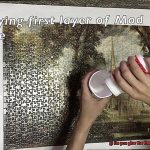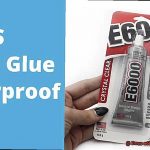Picture this: you’re surrounded by a kaleidoscope of colorful felt sheets, brimming with ideas for your next craft project. You’re ready to bring your imagination to life, but there’s one burning question on your mind – “Do I need special glue for felt?” Well, my friend, you’ve come to the right place.
Whether you’re a seasoned felt enthusiast or just dipping your toes into the world of crafting, understanding the ins and outs of special glues for felt is essential. We’re about to unravel the secrets behind this magical adhesive that holds together those stunning felt masterpieces.
Felt is like that quirky friend who’s both soft and sturdy at the same time. Its forgiving nature makes it a dream material to work with, but finding the perfect glue that can delicately bond its fibers without compromising its charm can be quite the challenge. But fear not. In this blog post, we’ll guide you through the labyrinth of special glues for felt crafts.
Get ready to embark on an adventure where we explore different types of glues specially designed for felt. From precision appliqué work to durable adhesion for your fuzzy accessories, we’ve got all the answers you need.
So grab your favorite cuppa, gather your crafting supplies, and let’s dive headfirst into the captivating world of special glue for felt crafts. Get ready to unleash your creativity like never before.
Regular Craft Glue and Fabric Glue for Bonding Felt
Contents
- 1 Regular Craft Glue and Fabric Glue for Bonding Felt
- 2 Special Glues for Felt: Advantages and Benefits
- 3 Hot Glue Guns and Hot Melt Adhesives for Bonding Felt
- 4 When Special Glue for Felt Might Not Be Necessary
- 5 Preparing the Surface Before Applying the Glue
- 6 Following Instructions of the Glue Manufacturer
- 7 Experimenting with Different Types of Glues
- 8 Conclusion
When it comes to crafting with felt, finding the perfect glue can make or break your project. Regular craft glue and fabric glue are two popular options, but what sets them apart? In this post, we’ll dive into the differences between these glues, exploring their advantages, disadvantages, and best uses for bonding felt.
Regular Craft Glue:
Regular craft glue, like dependable white school glue or clear drying craft glue, is a versatile option for bonding felt. It’s a favorite among crafters due to its ease of use and affordability. Craft glue dries clear, which is ideal for applications where the glue might be visible. Plus, it’s widely available in most stores and can be used for a variety of other craft projects.
Advantages:
- Simple to use and can be found almost anywhere
- Dries clear, ensuring an invisible bond
- Budget-friendly option
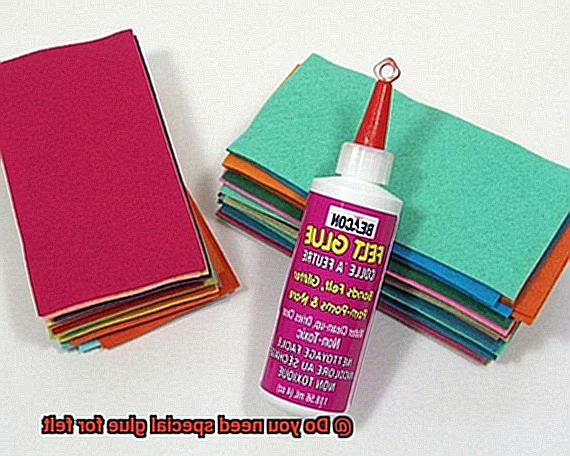
Disadvantages:
- May not withstand frequent washing
- Can leave a visible residue if applied too thickly or not allowed to dry completely
Fabric Glue:
Fabric glue is specially formulated for bonding fabric materials, including felt. It offers enhanced durability and resistance to washing, making it an excellent choice for felt projects that require frequent cleaning or washing. Fabric glues often have a flexible and waterproof finish, ensuring the bond remains intact even under humid or wet conditions.
Advantages:
- Designed specifically for fabric materials like felt
- Withstands washing and dry cleaning
- Provides a flexible and waterproof finish
Disadvantages:
- May leave a visible residue if applied too thickly or not allowed to dry completely
- Can be more expensive than regular craft glue
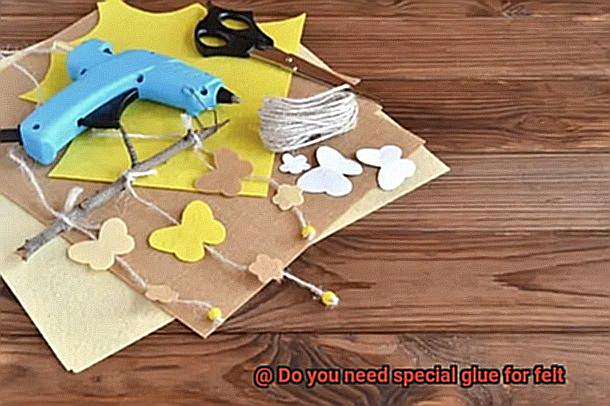
Best Uses:
Regular craft glue is generally suitable for most felt projects, especially those that don’t require extensive durability or washing. It works well for adhering small felt pieces together or attaching felt to a variety of surfaces.
Fabric glue shines in felt projects that demand a strong and long-lasting bond, such as stuffed animals, accessories, or items that will be frequently handled or washed. It adds durability and flexibility to the felt, ensuring the bond remains secure even with repeated use and cleaning.
Special Glues for Felt: Advantages and Benefits
Crafting with felt is a popular hobby that allows you to unleash your creativity and create beautiful and unique projects. Whether you’re making adorable plush toys, stylish accessories, or decorative items, using the right adhesive is essential to ensure that your creations stand the test of time. While regular craft glue may be versatile and budget-friendly, using special glues specifically designed for felt offers numerous advantages and benefits that can take your felt projects to the next level.
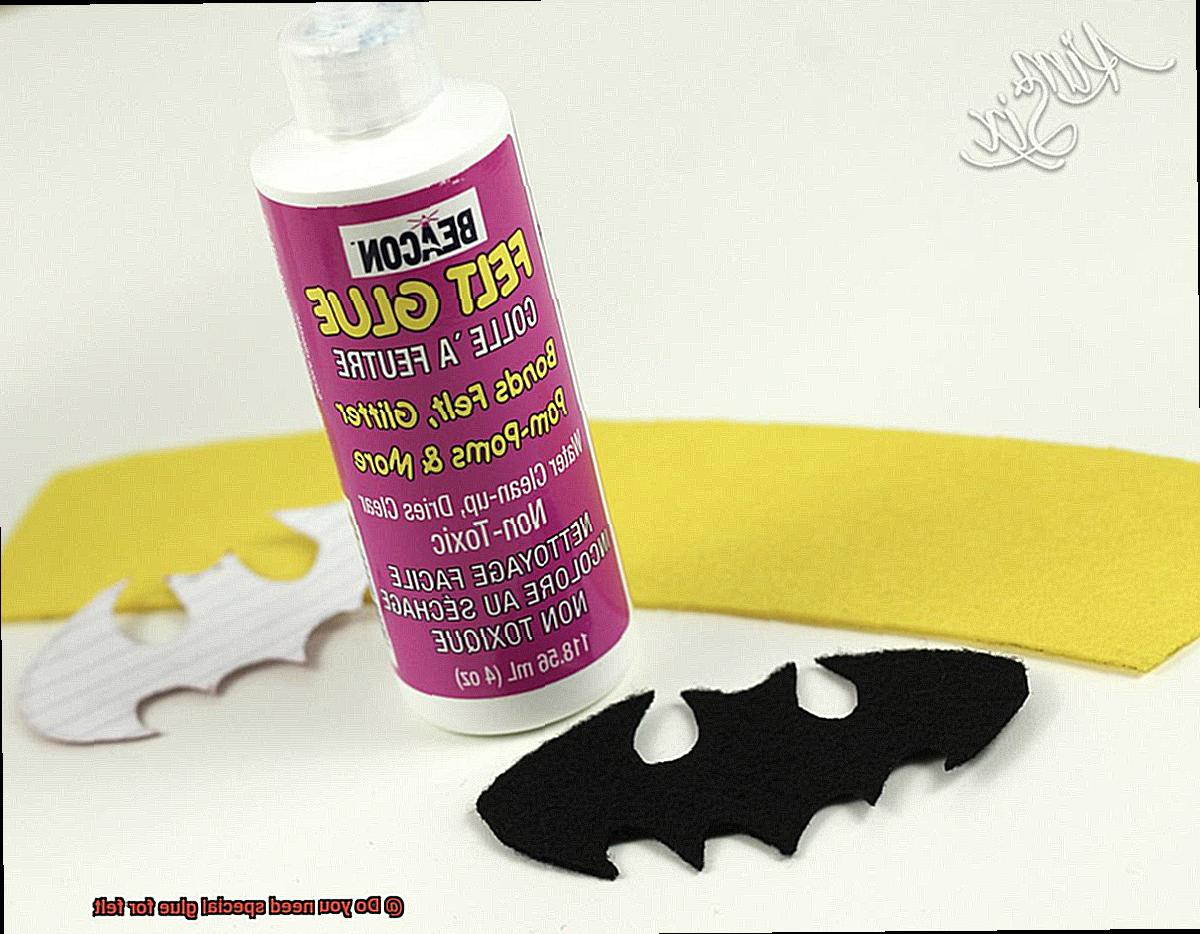
One of the key advantages of using special glues for felt is their ability to provide a strong and long-lasting bond. Felt can be a delicate material, and using the wrong type of glue can result in the fabric coming apart or losing its shape over time. Specialized felt glues are formulated to adhere to the unique texture and properties of felt, ensuring that your projects remain intact for years to come.
Special glues for felt are typically formulated to be non-toxic and safe for use on fabrics. This is particularly important when working on projects involving children or items that come into contact with the skin. You can have peace of mind knowing that the glue you’re using is safe for both you and your loved ones.
What sets special glues for felt apart from regular glues is their thicker consistency. This allows for better control and precision when applying the adhesive to the fabric. Say goodbye to messy drips and spills. The thick consistency ensures that the glue is applied exactly where you need it, even when working on intricate or detailed designs.
But the benefits don’t stop there. Some special glues for felt offer additional features such as quick drying times or heat resistance. Quick-drying glues can be advantageous when you’re working on time-sensitive projects, allowing you to complete your creations faster. Heat-resistant glues, on the other hand, are perfect for projects that may be exposed to high temperatures, ensuring that your felt items remain intact even in challenging environments.
When choosing a special glue for felt, it’s important to opt for high-quality and reputable brands. Reading product reviews and seeking recommendations from fellow crafters can be helpful in selecting the right glue for your specific project. While these specialized glues may sometimes come at a slightly higher price point compared to regular adhesives, their advantages and benefits make them a worthwhile investment for anyone working with felt on a regular basis.
Hot Glue Guns and Hot Melt Adhesives for Bonding Felt
Hot glue guns and hot melt adhesives are the dynamic duo for bonding felt. These versatile tools offer easy application, quick drying time, and tailored solutions to create strong and durable bonds. Whether you’re a craft enthusiast or a DIY lover, these adhesives are essential for making your felt projects stick.
Easy Application:
Hot glue guns make bonding felt a breeze. With a simple squeeze of the trigger, solid glue sticks are melted into a liquid adhesive that quickly solidifies upon cooling. This allows the glue to penetrate the fibers of the felt, creating a strong bond. It’s user-friendly and perfect for any crafting level.
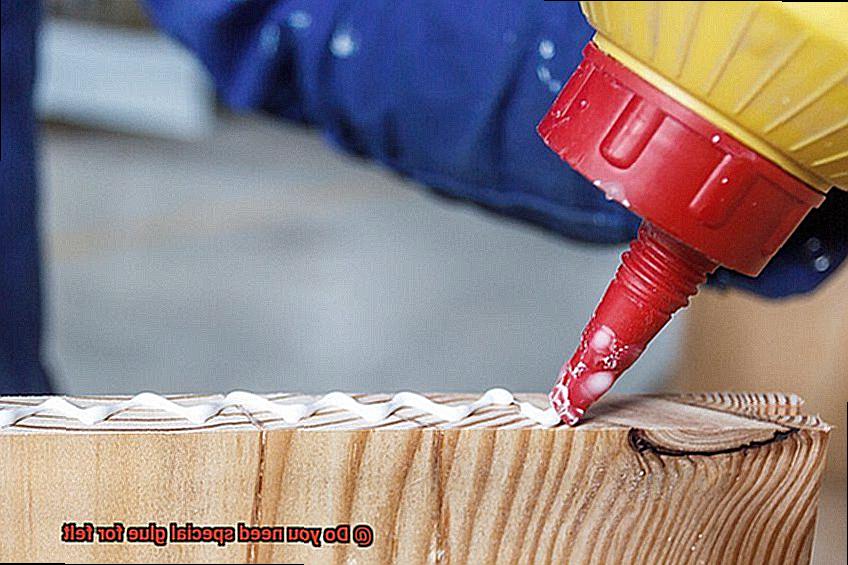
Quick Drying Time:
One of the greatest advantages of hot glue guns is their quick drying time. Within seconds, the adhesive solidifies, allowing for immediate handling of the bonded felt. This eliminates the risk of accidental detachment or displacement, making it ideal for small crafts or large-scale installations.
Versatility:
Hot glue guns can be used on various types of felt, including synthetic and natural felts. From lightweight crafts to heavy-duty projects, these guns provide the necessary adhesive strength. Crafters, DIY enthusiasts, and professionals alike use hot glue guns for their versatility and ability to bond different materials.
Tailored Solutions:
Hot melt adhesives offer excellent bonding capabilities tailored to specific needs. These thermoplastic materials become liquid when heated and solidify upon cooling. Different formulations cater to different requirements, allowing you to choose an adhesive compatible with felt and offering sufficient flexibility to accommodate fabric movements.
Proper Application and Handling:
To ensure optimal results, proper application and handling are crucial with hot melt adhesives. Apply the adhesive evenly onto the surfaces to be bonded and apply pressure for proper adhesion. Allow the adhesive to cool and solidify completely before subjecting the bonded felt to any stress or strain.
When Special Glue for Felt Might Not Be Necessary
Calling all crafters. Felt projects are a blast, but did you know that special glue isn’t always necessary? That’s right. In certain circumstances, alternative adhesives can work just as well. Let’s dive in and explore when special glue for felt might not be needed.
Crafts with a Gentle Touch:
For small crafts that don’t require a Herculean bond, regular craft glue or a trusty glue stick can do the trick. These adhesives keep your felt pieces in place without adding weight or bulk. Perfect for attaching felt to delicate materials like paper or lightweight fabrics.
Temporary Delights:
Creating something for a one-time event or a stage play? You don’t need to splurge on specialized felt glue. Temporary adhesives like double-sided tape or fabric adhesive dots are your go-to choices. They offer convenience and easy removal without harming the felt. Quick and temporary projects made easy.
Waterproof Wonders:
If your project needs frequent washing or exposure to water, special glue for felt might not be ideal. Felt glues often dissolve when wet, compromising the bond. Instead, opt for fabric glues designed to withstand water exposure and washing. Keep your felt creations intact even in the rain.
Preparing the Surface Before Applying the Glue
Crafters, get ready to take your felt projects to the next level. Whether you’re creating a plushie, a stylish bag, or some funky accessories, it’s crucial to know how to prep the surface before applying the glue. This step is the key to achieving a strong and long-lasting bond. So let’s dive in and explore the art of prepping.
First things first, let’s clean that felt surface. We don’t want any dirt or debris messing up our masterpiece, right? Gently wipe away any dust or dirt with a soft cloth. If you encounter stains or tougher grime, fear not. A mild detergent and water solution will come to the rescue. Just remember to steer clear of harsh chemicals that could harm your precious fabric.
Now, let’s get a little rough with that smooth texture of felt. It may look sleek, but it can make it challenging for glue to grip onto. Grab some fine-grit sandpaper and give the surface a gentle sanding. Think of it as giving your felt a massage, creating a slightly roughened texture that allows the glue to penetrate and bond more securely.
Next up, those pesky loose fibers need to go. Felt loves to hold onto them, but they can mess with our bonding mission. Take charge with a soft-bristled brush or trusty lint roller. Gently brush away those loose fibers until you achieve the smooth and clean surface we’re aiming for.
Now it’s time for a test run. Before committing fully, apply a small amount of glue on an inconspicuous area of the felt. Check for any damage or discoloration. If all looks good, give yourself a pat on the back and proceed with confidence.
Finally, let’s apply that glue like pros. Whether you’re using specialized felt glue or regular craft glue, apply it evenly and in a thin layer. Excess glue seeping through or stiff felt is a no-go. Use a brush or small applicator tool to ensure that the glue covers the entire surface evenly. And just like that, you’re ready to bond.
Following Instructions of the Glue Manufacturer
Before you dive in, remember this: always follow the instructions of the glue manufacturer. Trust me, it can make all the difference.
Different glues, different rules. Glue manufacturers know their stuff. They create specific glues for specific purposes, and felt is no exception. By following the instructions, you can ensure that you’re using the right glue for the job. No more guessing or hoping for the best.
The magic of special glues. Did you know there are glues specifically designed for fabrics, including felt? These glues are formulated to penetrate the fibers of the felt, creating a bond that’s strong and durable. By using these special glues, your felt creations will last for years to come.
Too much or too little. When it comes to glue, balance is key. Applying too much glue can result in a messy appearance and even stain your precious felt. On the other hand, using too little glue may lead to a weak bond that easily falls apart. Following the instructions ensures that you’re using just the right amount of glue for a perfect result.
Optimal bonding conditions. Some glues require specific conditions for optimal bonding. This could mean allowing the glue to dry for a certain period of time or applying pressure while it sets. By following the instructions, you can create the perfect environment for your glue to work its magic.
Now, not all types of felt require special glues. Some felts are more forgiving and can be successfully bonded with general-purpose glues. But if you want a strong and long-lasting bond, it’s always wise to use a glue recommended for use on felt.
Experimenting with Different Types of Glues
As you embark on your crafting journey, it’s important to understand that not all glues are created equal when it comes to working with felt. That’s why experimenting with different types of glues is crucial to ensure a strong and durable bond. So, gather your crafting tools and let’s dive into the sticky adventure of finding the perfect glue.
The Magic of Felt
Felt is a mesmerizing material that captivates crafters with its softness, versatility, and ability to hold its shape. However, this unique composition requires special attention when it comes to choosing the right glue. Picture felt as a tightly woven web of wool fibers, begging for a glue that can penetrate and create an unbreakable bond.
Fabric Glue – The Felt Whisperer
When it comes to bonding felt, fabric glue emerges as your trusted ally. Specially designed for fabrics, including our beloved felt, fabric glue provides a flexible and durable hold that is perfect for any felt project. Just follow the instructions on the bottle, and you’ll be sticking like a pro in no time.
Craft Glue – A Reliable Companion
Don’t fret if fabric glue isn’t available – craft glue or white glue can come to the rescue. While not as strong or durable as fabric glue, craft glue can still provide a decent bond with felt. However, it’s always wise to test it on a small piece of felt first to ensure it adheres well before committing to your main project.
Hot Glue Guns – Handle with Care
Ah, the trusty hot glue gun. With its quick-drying and strong bond, it seems like the perfect match for attaching felt pieces or securing embellishments. However, be cautious. The high temperature of the glue can potentially damage or melt the delicate fibers of the felt if not handled with care. To avoid mishaps, always perform a test on a scrap piece of felt and use low-temperature settings if available.
Tacky Glue – The Mighty Squeezy
Let’s not forget to mention tacky glue, another worthy contender in our glue exploration. This marvelous adhesive dries clear and remains flexible, making it ideal for bonding porous materials like felt. Its strong hold ensures that your felt creations stay intact without the glue seeping through the fabric.
iqVfblA-teM” >
Conclusion
In conclusion, the world of gluing felt is filled with options to suit every project’s needs. Craft glue and fabric glue are versatile choices that can work wonders for most felt crafts. Craft glue is a budget-friendly option that dries clear and is incredibly easy to use. On the other hand, fabric glue offers durability and resistance to washing, perfect for projects that need frequent cleaning or handling.
But let’s not forget about the special glues designed specifically for felt. These glues bring a whole new level of advantages and benefits to the table. They provide a strong and long-lasting bond, ensuring your creations stay intact over time. Plus, they’re often non-toxic and safe for fabrics, making them ideal for projects involving children or items in contact with the skin. With their thicker consistency, these special glues allow for better control and precision during application.
Hot glue guns and hot melt adhesives are another fantastic option for bonding felt. They offer quick drying times, easy application, and versatility in bonding different materials. These tools provide tailored solutions to create bonds that are as strong as they are durable.
Of course, there may be instances where special glue isn’t necessary. For smaller crafts or temporary projects, regular craft glue or double-sided tape can do the trick. And if your project involves frequent washing or exposure to water, opting for fabric glues designed specifically to withstand water exposure would be more suitable.
No matter which type of glue you choose, proper surface preparation is key to achieving optimal bonding results. Remember to clean the surface thoroughly, roughen it slightly with sandpaper if needed, remove any loose fibers, and carefully follow the instructions provided by the glue manufacturer.
Lastly, don’t be afraid to unleash your creativity by experimenting with different types of glues. Each one has its own unique characteristics and advantages when it comes to bonding felt.


